|
 |
|
 |
|
|
 |
|  |
|
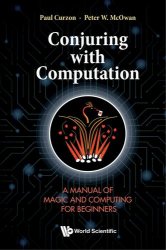 Название: Conjuring with Computation: A Manual of Magic and Computing for Beginners Название: Conjuring with Computation: A Manual of Magic and Computing for Beginners
Автор: Paul Curzon, Peter W. McOwan
Издательство: World Scientific Publishing
Год: 2023
Страниц: 421
Язык: английский
Формат: pdf (true)
Размер: 23.6 MB
The team behind Computer Science for Fun (CS4FN), brings you Conjuring with Computation: A Manual of Magic and Computing for Beginners. Develop your skills as a magician while also learning the basics of Computer Science by exploring its links to magic. Each chapter explains how to do a simple magic trick, step-by-step, then uses the trick to introduce linked fundamental ideas in Computer Science in a fun way. By reading the book you will learn to do self-working tricks, be able to hold magic shows, create your own versions of tricks, and with creativity even invent your own. We cover: Self-working card tricks Magical jigsaws, boxes and other objects False shuffles and cuts False choices Magic with books and pictures Mentalism, clairvoyance and tricks with ghosts Magic built on technology Find out your friends' superpowers! You will also learn how computation underpins conjuring, answering questions like: What is computation? Why are the skills of a computational thinker, such as decomposition, abstraction and generalisation, so important? Why is data represented in different ways? How is easy-to-use software created? How does maths underpin programming? What are the basics of cyber security and privacy? Why must we all understand how computing technology affects society? The book includes profiles of computer scientists, alongside magicians with links to technology, through history. Master conjuring and thinking computationally. | |
Разместил: Ingvar16 25-11-2024, 20:14 | Комментарии: 0 | Подробнее
| | | |
 |
|  |
 |
|
 |
|
|
 |
|  |
|
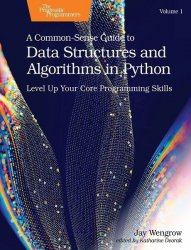 Название: A Common-Sense Guide to Data Structures and Algorithms in Python, Volume 1: Level Up Your Core Programming Skills Название: A Common-Sense Guide to Data Structures and Algorithms in Python, Volume 1: Level Up Your Core Programming Skills
Автор: Jay Wengrow
Издательство: Pragmatic Bookshelf
Год: 2024
Страниц: 489
Язык: английский
Формат: pdf (true), epub (true)
Размер: 12.1 MB, 24.2 MB
If you thought data structures and algorithms were all just theory, you're missing out on what they can do for your Python code. Learn to use Big O notation to make your code run faster by orders of magnitude. Choose from data structures such as hash tables, trees, and graphs to increase your code's efficiency exponentially. With simple language and clear diagrams, this book makes this complex topic accessible, no matter your background. Every chapter features practice exercises to give you the hands-on information you need to master data structures and algorithms for your day-to-day work. Algorithms and data structures are much more than abstract concepts. Mastering them enables you to write code that runs faster and more efficiently, which is particularly important for today's web and mobile apps. Take a practical approach to data structures and algorithms, with techniques and real-world scenarios that you can use in your daily production code. The Python edition uses Python exclusively for all code examples, exercise, and solutions. Use these techniques today to make your Python code faster and more scalable. | |
Разместил: Ingvar16 25-11-2024, 16:05 | Комментарии: 0 | Подробнее
| | | |
 |
|  |
 |
|
 |
|
|
 |
|  |
|
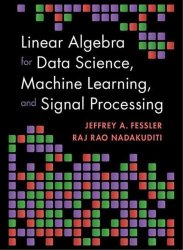 Название: Linear Algebra for Data Science, Machine Learning, and Signal Processing Название: Linear Algebra for Data Science, Machine Learning, and Signal Processing
Автор: Jeff Fessler, Raj Rao Nadakuditi
Издательство: Cambridge University Press
Год: 2024
Страниц: 451
Язык: английский
Формат: pdf
Размер: 29.2 MB
Maximise student engagement and understanding of matrix methods in data-driven applications with this modern teaching package. Students are introduced to matrices in two preliminary chapters, before progressing to advanced topics such as the nuclear norm, proximal operators and convex optimization. Highlighted applications include low-rank approximation, matrix completion, subspace learning, logistic regression for binary classification, robust PCA, dimensionality reduction and Procrustes problems. Extensively classroom-tested, the book includes over 200 multiple-choice questions suitable for in-class interactive learning or quizzes, as well as homework exercises (with solutions available for instructors). It encourages active learning with engaging 'explore' questions, with answers at the back of each chapter, and Julia code examples to demonstrate how the mathematics is actually used in practice. A suite of computational notebooks offers a hands-on learning experience for students. This is a perfect textbook for upper-level undergraduates and first-year graduate students who have taken a prior course in linear algebra basics. | |
Разместил: Ingvar16 25-11-2024, 15:22 | Комментарии: 0 | Подробнее
| | | |
 |
|  |
 |
|
 |
|
|
 |
|  |
|
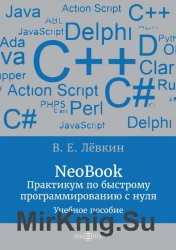 Название: NeoBook: Практикум по быстрому программированию с нуля Название: NeoBook: Практикум по быстрому программированию с нуля
Автор: Лёвкин В. Е.
Издательство: Директ-Медиа
Год: 2018
Cтраниц: 191 с. : ил.
Формат: pdf (ocr) / djvu
Размер: 13 мб
Язык: русский
Учебное пособие представляет собой специальную подборку практических заданий с подробными объяснениями и скриншотами, демонстрирующими пошаговый процесс создания нескольких полезных приложений в программном редакторе NeoBook.
NeoBook – это компьютерная программа, позволяющая неспециалистам в области программирования создавать свои, красивые, корректно работающие и профессионально выглядящие компьютерные программы для Windows практически любого назначения. | |
Разместил: rivasss 25-11-2024, 10:12 | Комментарии: 0 | Подробнее
| | | |
 |
|  |
 |
|
 |
|
|
 |
|  |
|
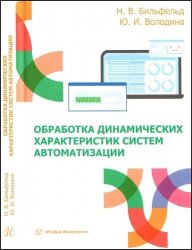 Название: Обработка динамических характеристик систем автоматизации: учебное пособие Название: Обработка динамических характеристик систем автоматизации: учебное пособие
Автор: Н.В. Бильфельд, Ю.И. Володина
Издательство: Инфра-Инженерия
Год: 2025
Страниц: 213
Язык: русский
Формат: pdf
Размер: 45.4 MB
Подробно рассмотрены методы обработки экспериментальных данных и результатов моделирования (динамических характеристик), которые содержатся в таких библиотеках, как Spline toolbox и Curve Fitting Toolbox. Рассмотрены методы обработки данных на уровне базовых команд MATLAB, обработка данных в графических окнах MATLAB, интерфейсы и команды библиотек Spline toolbox и Curve Fitting Toolbox и интерфейс программы «Многокритериальное исследование систем управления (MISU)». Система MATLAB в настоящее время принята в качестве официального средства оформления инженерной документации и научных публикаций. Язык программирования системы прост, он содержит несколько десятков операторов, а также большое количество процедур и функций, содержание которых понятно пользователю, позволяет использовать MATLAB практически во всех сферах научной и инженерной деятельности. За счет подключаемых библиотек (Toolbox) MATLAB позволяет решать задачи автоматизации, радиотехники, механики, аэродинамики, электротехники и электроники, картографии, биологии и других направлений. | |
Разместил: Ingvar16 25-11-2024, 07:12 | Комментарии: 0 | Подробнее
| | | |
 |
|  |
 |
|
 |
|
|
 |
|  |
|
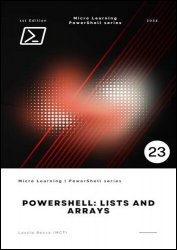 Название: PowerShell: Lists and Arrays Название: PowerShell: Lists and Arrays
Автор: Laszlo Bocso
Издательство: Independently published
Год: 2024
Страниц: 214
Язык: английский
Формат: pdf, epub, mobi
Размер: 10.1 MB
"PowerShell: Lists and Arrays" is an essential guide for IT professionals, system administrators, and developers looking to master data structures in PowerShell scripting. This comprehensive book offers a deep dive into the world of lists and arrays, providing both novice and experienced users with the knowledge and skills to enhance their scripting capabilities. This book is designed for both beginners and intermediate PowerShell users. If you are new to PowerShell, you will find detailed explanations and hands-on examples that introduce key concepts in a clear and accessible manner. For those who already have some experience with PowerShell, this book will serve as a deep dive into lists and arrays, uncovering techniques and best practices that will enhance your scripting capabilities. We will explore various ways to create, manipulate, and utilize these data structures, building up from basic definitions to more complex, real-world scenarios. Whether you're new to PowerShell or looking to enhance your existing skills, this book provides the knowledge and practical experience needed to excel in PowerShell scripting. From automating routine tasks to managing large-scale systems, "PowerShell: Lists and Arrays" equips you with the tools to become a more effective and resourceful IT professional. | |
Разместил: Ingvar16 25-11-2024, 06:23 | Комментарии: 0 | Подробнее
| | | |
 |
|  |
 |
|
 |
|
|
 |
|  |
|
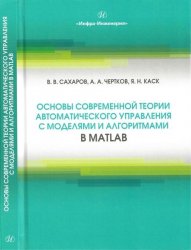 Название: Основы современной теории автоматического управления с моделями и алгоритмами в MATLAB: учебное пособие Название: Основы современной теории автоматического управления с моделями и алгоритмами в MATLAB: учебное пособие
Автор: В.В. Сахаров, А.А. Чертков, Я.Н. Каск
Издательство: Инфра-Инженерия
Год: 2025
Страниц: 220
Язык: русский
Формат: pdf
Размер: 58.6 MB
Рассмотрены основные условия устойчивости, управляемости и наблюдаемости объектов управления и синтеза систем с применением численных методов динамического программирования, QR-преобразования и оптимального управления. Приведены основы построения, модели и алгоритмы синтеза систем автоматического управления с конкретными примерами их алгоритмизации и моделирования в вычислительной среде MATLAB, позволяюшис решать исследовательские и практические задачи управления на основе современного инструментария вычислительных и программных средств, а также компьютерных технологий. Учебное пособие состоит из тринадцати глав, в которых приводятся необходимые теоретические сведения, рассматриваются примеры и задачи с реализацией решения в среде MATLAB при использовании пакетов прикладных программ Control System Toolbox (CST) и Simulink. | |
Разместил: Ingvar16 24-11-2024, 18:59 | Комментарии: 0 | Подробнее
| | | |
 |
|  |
 |
|
 |
|
|
 |
|  |
|
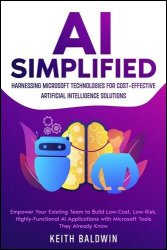 Название: AI Simplified: Harnessing Microsoft Technologies for Cost-Effective Artificial Intelligence Solutions Название: AI Simplified: Harnessing Microsoft Technologies for Cost-Effective Artificial Intelligence Solutions
Автор: Keith Baldwin
Издательство: eBookIt.com
Год: 2024
Страниц: 223
Язык: английский
Формат: pdf (true)
Размер: 23.2 MB
AI Simplified: Harnessing Microsoft Technologies for Cost-Effective Artificial Intelligence Solutions is your practical guide to unlocking the power of AI within your organization without breaking the bank or hiring new specialized teams. Tailored for business leaders, executives, managers, and technical professionals, this book demystifies Artificial Intelligence (AI) and provides actionable steps to integrate AI solutions effectively using tools and platforms you already know. The main goal of this book is to equip business leaders, executives, managers, programmers, and database administrators with the knowledge and tools they need to effectively leverage Artificial Intelligence (AI) within their organizations. Our mission is to make AI approachable and actionable for businesses eager to exploit this potential. AI can appear overwhelming, shrouded in jargon and complex technicalities. Yet, when demystified and implemented effectively, it can address critical business challenges, automate mundane tasks, perform functions beyond the scope of traditional programming, and provide insights that inform strategic decisions. | |
Разместил: Ingvar16 24-11-2024, 15:13 | Комментарии: 0 | Подробнее
| | | |
 |
|  |
 |
|
 |
|
|
 |
|  |
|
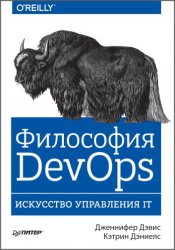 Название: Философия DevOps: Искусство управления IT Название: Философия DevOps: Искусство управления IT
Автор: Кэтрин Дэниелс, Дженнифер Дэвис
Издательство: Питер
Год: 2017
Страниц: 416
Язык: Русский
Формат: pdf/djvu
Размер: 31 Mb
IT-принцип «agile» стал мантрой цифровой эпохи. С ростом проектов, переходом от монолитных приложений к системе микросервисов, увеличением и накоплением продуктов возникают вопросы, которые требуют совершенно иного подхода. Теперь наибольший интерес вызывает находящаяся на стыке разработки и операционного управления методология DevOps. | |
Разместил: rivasss 24-11-2024, 08:16 | Комментарии: 0 | Подробнее
| | | |
 |
|  |
 |
|
 |
|
|
 |
|  |
|
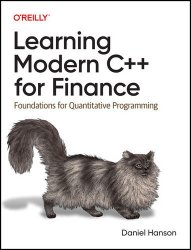 Название: Learning Modern C++ for Finance: Foundations for Quantitative Programming (Final Release) Название: Learning Modern C++ for Finance: Foundations for Quantitative Programming (Final Release)
Автор: Daniel Hanson
Издательство: O’Reilly Media, Inc.
Год: 2025
Страниц: 431
Язык: английский
Формат: True/Retail PDF, True/Retail EPUB
Размер: 10.1 MB
This practical book demonstrates why C++ is still one of the dominant production-quality languages for financial applications and systems. Many programmers believe that C++ is too difficult to learn. Author Daniel Hanson demonstrates that this is no longer the case, thanks to modern features added to the C++ Standard beginning in 2011. Financial programmers will discover how to leverage C++ abstractions that enable safe implementation of financial models. You’ll also explore how popular open source libraries provide additional weapons for attacking mathematical problems. C++ programmers unfamiliar with financial applications also benefit from this handy guide. | |
Разместил: Ingvar16 24-11-2024, 05:57 | Комментарии: 0 | Подробнее
| | | |
 |
|  |
|